
Ungulates are members of the diverse clade Euungulata, which primarily consists of large mammals with hooves. Once part of the clade "Ungulata" along with the clade Paenungulata, "Ungulata" has since been determined to be a polyphyletic and thereby invalid clade based on molecular data. As a result, true ungulates had since been reclassified to the newer clade Euungulata in 2001 within the clade Laurasiatheria while Paenungulata has been reclassified to a distant clade Afrotheria. Living ungulates are divided into two orders: Perissodactyla including equines, rhinoceroses, and tapirs; and Artiodactyla including cattle, antelope, pigs, giraffes, camels, sheep, deer, and hippopotamuses, among others. Cetaceans such as whales, dolphins, and porpoises are also classified as artiodactyls, although they do not have hooves. Most terrestrial ungulates use the hoofed tips of their toes to support their body weight while standing or moving. Two other orders of ungulates, Notoungulata and Litopterna, both native to South America, became extinct at the end of the Pleistocene, around 12,000 years ago.
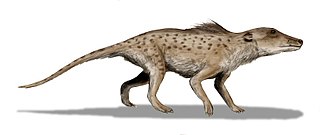
Pakicetidae is an extinct family of Archaeoceti that lived during the Early Eocene in Pakistan. Unlike modern cetaceans, they had well-developed limbs and were capable of walking.
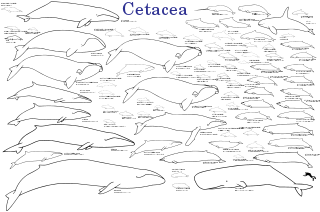
The evolution of cetaceans is thought to have begun in the Indian subcontinent from even-toed ungulates (Artiodactyla) 50 million years ago (mya) and to have proceeded over a period of at least 15 million years. Cetaceans are fully aquatic mammals belonging to the order Artiodactyla and branched off from other artiodactyls around 50 mya. Cetaceans are thought to have evolved during the Eocene, the second epoch of the present-extending Cenozoic Era. Molecular and morphological analyses suggest Cetacea share a relatively recent closest common ancestor with hippopotami and that they are sister groups. Being mammals, they surface to breathe air; they have five finger bones (even-toed) in their fins; they nurse their young; and, despite their fully aquatic life style, they retain many skeletal features from their terrestrial ancestors. Research conducted in the late 1970s in Pakistan revealed several stages in the transition of cetaceans from land to sea.
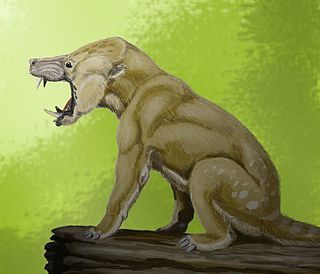
Condylarthra is an informal group – previously considered an order – of extinct placental mammals, known primarily from the Paleocene and Eocene epochs. They are considered early, primitive ungulates and is now largely considered to be a wastebasket taxon, having served as a dumping ground for classifying ungulates which had not been clearly established as part of either Perissodactyla or Artiodactyla, being composed thus of several unrelated lineages.

Pakicetus is an extinct genus of amphibious cetacean of the family Pakicetidae, which was endemic to Indian Subcontinent during the Ypresian period, about 50 million years ago. It was a wolf-like mammal, about 1–2 m long, and lived in and around water where it ate fish and other animals. The name Pakicetus comes from the fact that the first fossils of this extinct amphibious whale were discovered in Pakistan. The vast majority of paleontologists regard it as the most basal whale, representing a transitional stage between land mammals and whales. It belongs to the even-toed ungulates with the closest living non-cetacean relative being the hippopotamus.
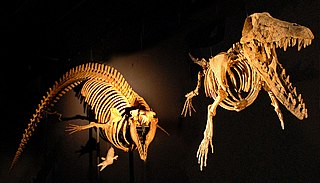
Archaeoceti, or Zeuglodontes in older literature, is a paraphyletic group of primitive cetaceans that lived from the Early Eocene to the late Oligocene. Representing the earliest cetacean radiation, they include the initial amphibious stages in cetacean evolution, thus are the ancestors of both modern cetacean suborders, Mysticeti and Odontoceti. This initial diversification occurred in the shallow waters that separated India and Asia 53 to 45 mya, resulting in some 30 species adapted to a fully oceanic life. Echolocation and filter-feeding evolved during a second radiation 36 to 35 mya.

Anthracobune is an extinct genus of stem perissodactyl from the middle Eocene of the Upper Kuldana Formation of Kohat, Punjab, Pakistan.
Himalayacetus is an extinct genus of carnivorous aquatic mammal of the family Ambulocetidae. The holotype was found in Himachal Pradesh, India, in what was the remnants of the ancient Tethys Ocean during the Early Eocene. This makes Himalayacetus the oldest archaeocete known, extending the fossil record of whales some 3.5 million years.
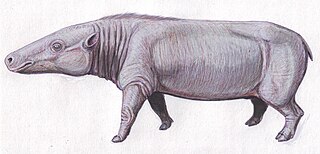
Anthracotheriidae is a paraphyletic family of extinct, hippopotamus-like artiodactyl ungulates related to hippopotamuses and whales. The oldest genus, Elomeryx, first appeared during the middle Eocene in Asia. They thrived in Africa and Eurasia, with a few species ultimately entering North America during the Oligocene. They died out in Europe and Africa during the Miocene, possibly due to a combination of climatic changes and competition with other artiodactyls, including pigs and true hippopotamuses. The youngest genus, Merycopotamus, died out in Asia during the late Pliocene, possibly for the same reasons. The family is named after the first genus discovered, Anthracotherium, which means "coal beast", as the first fossils of it were found in Paleogene-aged coal beds in France. Fossil remains of the anthracothere genus were discovered by the Harvard University and Geological Survey of Pakistan joint research project (Y-GSP) in the well-dated middle and late Miocene deposits of the Pothohar Plateau in northern Pakistan.

Ichthyolestes is an extinct genus of archaic cetacean that was endemic to Indo-Pakistan during the Lutetian stage. To date, this monotypic genus is only represented by Ichthyolestes pinfoldi.
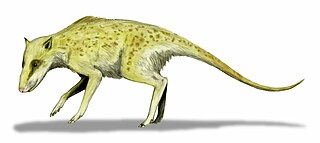
Indohyus is an extinct genus of digitigrade even-toed ungulates known from Eocene fossils in Asia. This small chevrotain-like animal found in the Himalayas is one of the earliest-known non-cetacean ancestors of whales.

Remingtonocetus is an extinct genus of early cetacean freshwater aquatic mammals of the family Remingtonocetidae endemic to the coastline of the ancient Tethys Ocean during the Eocene. It was named after naturalist Remington Kellogg.

Remingtonocetidae is a diverse family of early aquatic mammals of the order Cetacea. The family is named after paleocetologist Remington Kellogg.
Mulkrajanops is a genus of brontothere endemic to India during the Eocene living from 55.8 to 48.6 mya, existing for approximately 7.2 million years.
Babiacetus is an extinct genus of early cetacean that lived during the late Lutetian middle Eocene of India . It was named after its type locality, the Harudi Formation in the Babia Hills, Kutch District, Gujarat, India.

Andrewsiphius is an extinct remingtonocetid early whale known from the Eocene of Gujarat and Kutch, India and Balochistan, Pakistan.

Indocetus is a protocetid early whale known from the late early Eocene Harudi Formation in Kutch, India.

Johannes Gerardus Marie (Hans) Thewissen is a Dutch-American paleontologist known for his significant contributions to the field of whale evolution. Thewissen's fieldwork has led to the discovery of key fossils that have shed light on the transition of whales from land to water, including the discovery of Ambulocetus, Pakicetus, Indohyus, and Kutchicetus. In addition to his work on fossil discoveries, Thewissen also studies modern bowhead and beluga whales in Alaska, focusing on their biology and the implications of this knowledge for management and conservation efforts. His research has been instrumental in deepening our understanding of cetacean evolution and the adaptations that allowed these mammals to transition from terrestrial to fully aquatic lifestyles.

The Andrewsiphiinae is an extinct subfamily of early whales of the family Remingtonocetidae. Thiewessen & Bajpai (2009) proposed the clade when Andrewsiphius and Kuchicetus were accepted as separate genera. Kuchicetus was originally synonymized with Andrewsiphius in 2001 by Gingerich et al., but later authors, however, still accept both as separate genera.

Sunil Bajpai is the Chair Professor of Vertebrate Paleontology in the Department of Earth Sciences, Indian Institute of Technology Roorkee. He is in service as a professor at IIT Roorkee since 1st January 1996 till 30 September 2026. He also served as the director of the Birbal Sahni Institute of Palaeosciences from January 2013 to July 2018.















